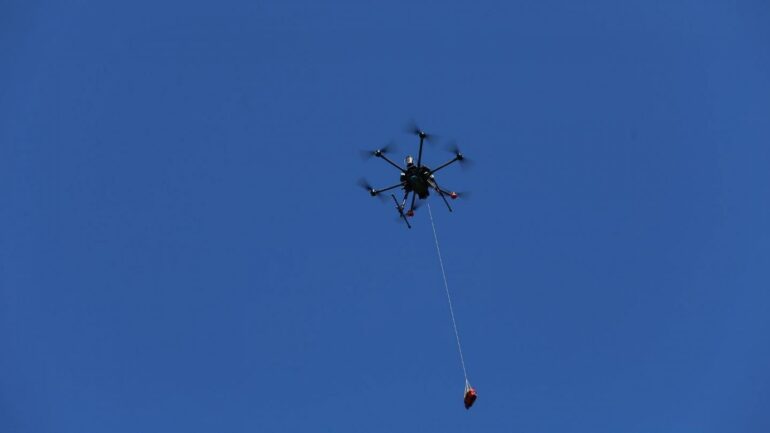As a kid, Justin Boutilier would sometimes get roped into helping his dad, a paramedic and firefighter, perform automated external defibrillator (AED) demonstrations in and around his hometown of Niagara Falls, Canada.
“If a kid can use an AED, so can you,” he says, recalling one of his dad’s messages during those visits to local office buildings or hotel conference rooms.
Two decades later, Boutilier, now an assistant professor of industrial and systems engineering at the University of Wisconsin–Madison, is trying to help reimagine how AEDs can save more lives.
In a paper published in the journal Manufacturing & Service Operations Management, Boutilier details the framework for designing a network of AED-outfitted, autonomous flying drones, which could allow the life-saving devices to more quickly reach people experiencing cardiac arrest. In out-of-hospital cardiac arrests, survival rates drop by as much as 10% for each minute that passes without treatment, according to a previous analysis coauthored by Boutilier.
“Ambulances are not fast enough for this, especially in non-urban areas, so drones are just such a good fit,” says Boutilier, whose research harnesses optimization and machine learning techniques to improve healthcare quality, access and delivery. “They’re super fast with straight-line flight. And then AEDs are a relatively light payload, so it suits the drone. The best applications for drones in healthcare are things that are light and where time is of the essence.”
The idea of drone-delivered AEDs may sound futuristic, but it’s slowly gained traction since Boutilier and Timothy Chan, Boutilier’s graduate school advisor at the University of Toronto and co-author on the new study, first saw a video of a team from Delft University of Technology in the Netherlands showcasing a prototype in 2016.
In January 2022, an off-duty doctor used an AED delivered by an autonomous drone to save a 71-year-old man’s life in Sweden—the first such documented successful rescue—as part of a nascent program in the Scandinavian country. The company Drone Delivery Canada has also conducted tests with simulated cardiac arrest situations in Ontario in recent years.
Boutilier is hopeful research like his, which draws on cardiac arrest and emergency response time data from a more than 10,000-square-mile area around Toronto, will help nudge the technology closer toward mainstream implementation.
In the paper, he and Chan present system designs for either improving average response time or curbing the range of slowest response times. Between those two options, they estimate that such a drone network could produce a 42% to 76% higher survival rate among people experiencing out-of-hospital cardiac arrests, with up to 144 lives saved each year within that geographical area. And, they note, a modest number of drones can have a significant effect; per their analysis, one base with three drones could improve average response time in Toronto by one minute.
Boutilier says policymakers will need to consider both moral dilemmas—prioritizing average response time would lead to a larger concentration of drones in urban areas—and logistical hurdles such as flight regulations and navigational challenges in crowded cities.
“Whereas rural areas are much easier for drones to fly, and response times are historically worse, so the improvements you’ll make will be big, potentially,” he says. “But there’s not going to be as many cardiac arrests.”
Boutilier is now pursuing funding with collaborators at Purdue, the University of Illinois, the University of Pittsburgh and the University of North Carolina to investigate more models for system designs while also exploring ways to ensure people can effectively use drone-delivered AEDs.
“I think there are still a lot of questions about the design of drones, what’s the best way for a human to interact with a drone both safely and efficiently, so people are comfortable with it,” he says. “Historically, AEDs have seen such limited use, even when they’re put in public places. I think we need to be careful with drones to make sure we don’t end up in a similar situation, that we figure out what we need to do to make these usable by bystanders.”
More information:
Justin J. Boutilier et al, Drone Network Design for Cardiac Arrest Response, Manufacturing & Service Operations Management (2022). DOI: 10.1287/msom.2022.1092
Provided by
University of Wisconsin-Madison
Citation:
Drone-delivered defibrillators could save lives (2022, May 11)



